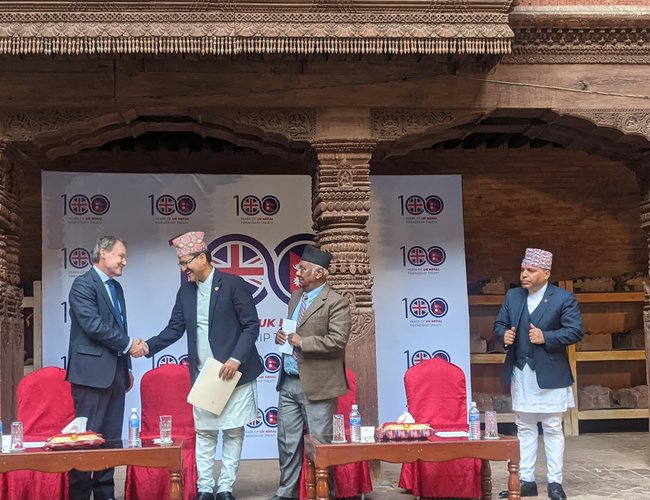
Nepal and the United Kingdom treasure over two hundred years of bilateral relations. As the first European power to come into contact, Nepal-UK relations constitute very important part of our external engagements in the 18th, 19th and 20th century and the treaty of 1923 stands as a historic milestone in the evolution and consolidation of those relations.
For a Nepali, it is a fact of history that we were never reduced to a colony and remained independent even during the climax of British Empire in the South Asian subcontinent. The Friendship Treaty of 1923 unequivocally reiterates that very fact in the form of a formal bilateral legal instrument.
The historic facts such as the Treaty of Sugauli, treaties of 1792 and 1801, the Extradition Treaty of 1855 and its two subsequent memoranda, Jung Bahadur’s refusal to surrender the refugees taking political asylum in Nepal, Nepal’s engagement with China and Tibet in 1792 and 1856 and continuation of diplomatic representation with them, and the fact that Nepal raised and maintained its independent army ever since its existence and no external power ever exercised extraterritorial rights over Nepal amply establish Nepal’s uninterrupted independent status.
However, in the height of colonial expansion in the South Asia, the Rana rulers of Nepal chose the policy of self-isolation, tightly insulating internal political and social system from external influence.
It was during this prolonged period of self-isolation, particularly after the death of Prime Minister Jung Bahadur Rana, perhaps the de facto practice of our rulers gave sometimes the room for ambiguity as regard to Nepal’s status in terms of her external engagements. This was a matter of concern to successive Rana Prime Ministers after Jung Bahadur.
The background of Nepal’s critical assistance to control the mutiny in 1856, exceptional services rendered during the Younghusband’s Mission to Tibet, the First World War and the third Afghan War of 1919and the British decision to conclude Anglo-Afghan Treaty of 1921provided sufficiently right atmosphere for Prime Minister Chandra Shamsher to firmly assert for a similar treaty in favor of Nepal.
The two sides engaged in extensive internal consultation and preparation before the negotiation on the text started.
With prolonged back and forth, the negotiation of the Treaty took a considerable amount of time. Viceroy Reading gives the reason for delay “due to the necessity of subjecting all aspects of the question to that careful scrutiny which a matter so momentous deserves.”
Chandra Shumshere was regarded as a close ally of the British Government. Throughout the negotiation process, he appears to have been concerned that the content of the Treaty should not be embarrassing to Nepal when it is brought to the public.
In his letter of 14 September 1923 addressed to the Governor General, he stated that “success or otherwise of the document in public estimation will form a criterion of the success or otherwise of his policy” and “when the document is made public, Nepal may not have to hang down her head.” Therefore, in the process, references to the sensitive issues were either carefully crafted or avoided altogether.
At the end, the final text of the seven-article treaty was agreed upon a designed on 21 December 1923 in Singh Durbar under the authority of His Majesty’s Government in London, with the full power credentials duly addressed to King Tribhuvan and vice versa.
On Nepal’s request, the Treaty was ratified by King Emperor George V himself not by the Viceroy in India. The ratified copies were exchanged on April 8, 1924.
It was registered with the League of Nations on 3 August 1925 in line with the practice of “new diplomacy”that came into being after WWIimplying that all treaties and engagements between States are conducted in open and transparent manner.
Through the Treaty, the Governments of Nepal and Great Britain mutually acknowledge and respect each other’s internal and external independence and confirm all previous treaties and engagements, including the Treaty of Sugauli.
It recognizes the right of Nepal to import arms, ammunition, and machinery to meet its requirements.
The treaty also recognizes for the first time what we call today the transit right for the goods imported by Nepal and provides for exemption of customs duty in the British Indian ports.
In the words of Prime Minister Chandra Shumshere, “the Treaty marked a new era in the traditional friendship between Nepal and the Great Britain” and in the words of Viceroy Reading it “inaugurated another prolonged period of concord and friendship”.
The treaty opened Nepal’s external engagements considerably.Representatives of France and Italy visited Nepal in subsequent years. Nepal was invited to attend international conferences under the auspices of the League of Nations and others, which Prime Minister Chandra Shamsherchose not to attend.
Nepal opened its first Embassy in London in 1934with an enhanced level of representation, and the British Government reciprocated by appointing “Envoy Extraordinary and Minister Plenipotentiary” at its legation in Kathmandu.
For a practitioner of diplomacy and foreign policy, the Treaty provides important lessons on many facets of our foreign engagement and diplomacy:
First and foremost, looking from the hindsight, the Treaty epitomizes the resilience and persistence of Nepali diplomacy in the height of colonialism in South Asia and provides a case study of friendly relations between two States of different size and power.
Second, going through the papers of negotiation and records of both encouraging and frustrating exchanges within and between the two sides, this treaty provides a case of reasonably successful negotiation to materialize the aspiration of securing de jurerecognition of independence from the sole superpower of the time. There were many other bigger, more resourceful and perhaps more powerful states in the region that were vying for securing such recognition but could not succeed.
Third, the Treaty firmly established the historic fact that Nepal was different from princely states of the sub-continent in terms of its sovereignty and was capable of fully establishing that fact. This has been eloquently clarified by the British officials in response to the complaint lodged to them in 1924 by the Maharaja of Gwalior as why his state was not accorded the similar treatment to that of Nepal.
Fourth, this was a Treaty with the sole superpower of the time by completing extensive negotiation process that provided a great deal of confidence to Nepal. It was a different time, when most countries of Asia and Africa were under colonial rule. The wave of independence in fact came only after the end of WW II. It was before the establishment of the United Nations and elaboration of its Charter principles. The League of Nations had just been established but lacked universal membership and the practice of “new diplomacy” was not as widespread.
Fifth, the Treaty introduced Nepal a modern practice of diplomacy and inter-state relations, brought Nepal into the comity of nations and facilitated expansion of its independent outlook to larger international arena.Significantly, the Treaty was a solid international instrument that Nepal concluded as a sovereign and independent country. The mutual assertion of “internal and external independence” spelled out in Article I of the Treaty later served as an important window in Nepal’s pursuit of membership of the United Nations.
And finally, over the past hundred years, the treaty has served the interest of our two countries welland we have successfully lived up with the aspiration of “further strengthening and cementing of the good relations and friendship” as spelled out in the preamble of the Treaty. Our friendship has remained solid, uninterrupted and has now been expanded to multiple areas of cooperation.
Before I conclude, let me underline that the substance and contours of Nepal-UK relations have significantly expanded and evolved over the past one hundred years encompassing political dialogues, economic partnerships,trade and investment, tourism, exploration, mountaineering, diaspora, British Gurkhas, and other dimensions of people-to-people linkages as well as working together in multilateral forums on several agendas of mutual interest. The Gorkha connection continues to be a unique link between our two countries.
It is now the time that we look for defining the relationship for the next hundred years by duly appreciating the past and providing a new direction of relations that is modern, forward-looking, founded on accepted norms of international relations, builds on our strengths, provides hope and scope for future generations to engage, nurture, and expand everlasting friendship and benefit from all aspects of it.
Bharat Raj Paudyal is a former Foreign Secretary of Government of Nepal. Excerpts of his opinion delivered at 1923 Nepal-UK Treaty Conference organized by Madan Puraskar Pustakalaya, Lalitpur last week.
- The Flagship Annual Lecture Series
- Jun 26, 2023
- Nepal Is Bearing The Disproportionate Burden Of Climate Change
- Sep 27, 2022
- Nepal Has Consistently Supported Israel’s Right To Live In Peace
- May 19, 2022
- UNICEF’s Work In The South Asia Too Has Yielded Some Remarkable Results: Foreign Secretary Paudyal
- Dec 10, 2021
- Indian Ocean: “Ecology, Economy, Epidemic”
- Dec 07, 2021

















